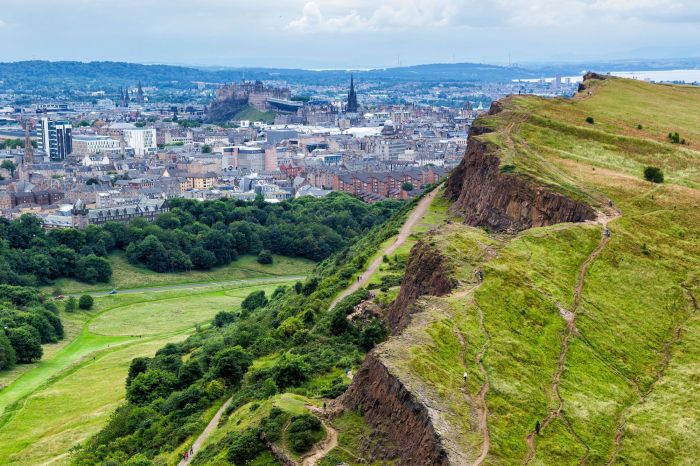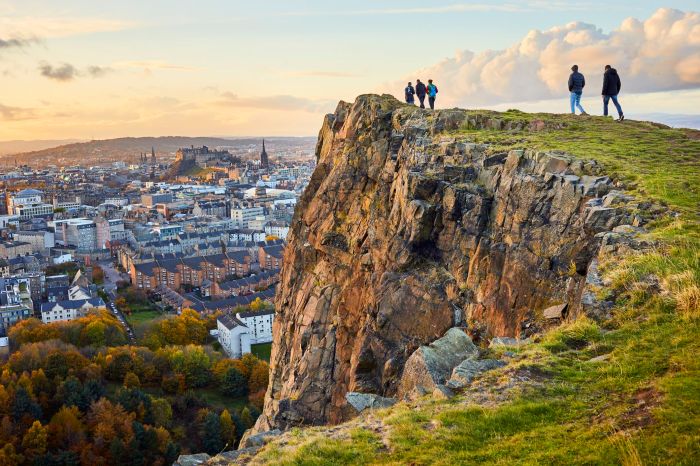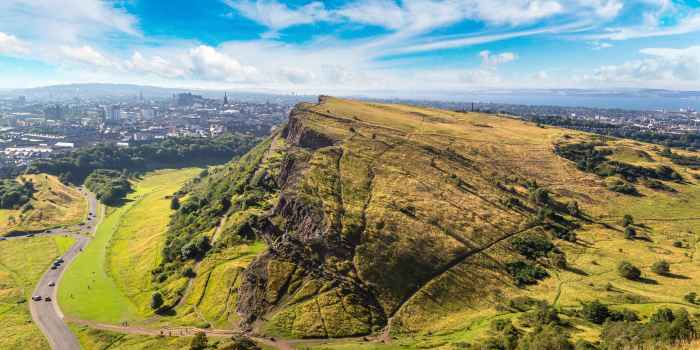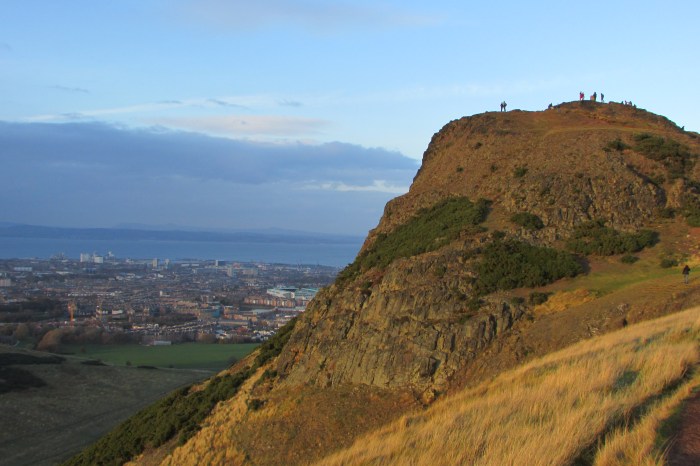Arthurs seat – Arthur’s Seat, the captivating hilltop that overlooks Edinburgh, Scotland, is a geological marvel steeped in history and ecological significance. Its unique volcanic origins and diverse flora and fauna make it a must-visit destination for hikers, nature enthusiasts, and history buffs alike.
From its ancient monuments to its stunning panoramic views, Arthur’s Seat offers a captivating experience that will leave a lasting impression.
Geological Formation

Arthur’s Seat, an extinct volcano, stands as a prominent landmark in Edinburgh, Scotland. Its geological composition primarily comprises volcanic rocks formed during a series of volcanic eruptions that occurred approximately 350 million years ago.
The volcanic activity that shaped Arthur’s Seat can be attributed to the Carboniferous period, a time when the Earth’s crust was subjected to intense geological forces. During this period, molten rock, or magma, rose from deep within the Earth’s mantle and erupted onto the surface, forming volcanoes and depositing layers of volcanic material.
Unique Rock Formations
Arthur’s Seat exhibits a diverse array of rock formations, each bearing witness to the complex geological processes that have shaped the hill over millions of years. These formations include:
- Dolerite: A dark, fine-grained igneous rock that forms the core of Arthur’s Seat, dolerite is the result of magma cooling slowly underground.
- Basalt: A dark, fine-grained volcanic rock formed from rapidly cooled lava, basalt is found in the Whin Sill, a prominent rock formation on the eastern side of the hill.
- Sandstone: A sedimentary rock composed of sand grains, sandstone is found in the Salisbury Crags, a series of cliffs on the northern side of Arthur’s Seat.
- Tuff: A volcanic rock formed from the consolidation of volcanic ash, tuff is found in various locations on Arthur’s Seat, including the Lion’s Head, a distinctive rock formation resembling a lion’s head.
Historical Significance: Arthurs Seat

Arthur’s Seat, towering over Edinburgh, Scotland, holds immense historical significance, intertwined with the city’s rich tapestry of events and legends. From ancient times to the present day, the hill has witnessed pivotal moments and played a profound role in Scottish folklore and culture.
Ancient Monuments and Ruins, Arthurs seat
Arthur’s Seat is home to several ancient monuments and ruins that attest to its long and eventful history. Among the most notable are:
- The Salisbury Crags: A series of sheer cliffs formed by volcanic activity, they served as a defensive stronghold in the Iron Age and later became a popular climbing destination.
- The Arthur’s Seat Hill Fort: An Iron Age hill fort dating back to the 2nd century BC, it once housed a community of around 1,000 people and offered panoramic views of the surrounding landscape.
- St. Anthony’s Chapel: A 15th-century chapel dedicated to St. Anthony, it was built on the site of a hermitage and became a popular pilgrimage destination.
- Duddingston Loch: A picturesque loch located at the foot of Arthur’s Seat, it is believed to have been a sacred site for the ancient Celts and was later used as a source of drinking water for Edinburgh.
Ecological Importance

Arthur’s Seat is renowned for its rich biodiversity, supporting a diverse array of flora and fauna. The hill’s unique geological formations and microclimates create distinct habitats for a wide range of species.
Arthurs Seat, an extinct volcano in Edinburgh, offers breathtaking views of the city and beyond. For a cultural immersion, explore the best cultural festivals worldwide , where you’ll experience vibrant traditions, music, and art. Back at Arthurs Seat, soak in the panoramic vistas and reflect on the rich tapestry of human culture.
The flora of Arthur’s Seat includes a variety of plant communities, from heather moorland to grasslands and woodlands. Notable plant species include the rare spring sandwort, which thrives on the hill’s rocky slopes. The hill is also home to numerous lichen species, adding to its ecological diversity.
Arthurs Seat, a prominent landmark in Edinburgh, offers breathtaking panoramic views. Its rugged terrain and historical significance make it a popular destination. Exploring the region around Arthurs Seat, one may stumble upon hidden gems like the vibrant city of Almeria in southern Spain.
Almeria boasts a rich cultural heritage, stunning beaches, and delectable cuisine. Returning to Arthurs Seat, its summit provides an unparalleled perspective of the surrounding landscape, leaving an unforgettable impression on visitors.
Fauna
Arthur’s Seat is home to a variety of animal species, including birds, mammals, and invertebrates. Notable bird species include the peregrine falcon, which nests on the hill’s cliffs, and the common buzzard. Mammals found on the hill include foxes, rabbits, and squirrels. The hill’s invertebrate population includes a variety of insects, spiders, and mollusks.
Arthurs Seat, a prominent hill in Edinburgh, offers breathtaking views of the city and beyond. Its historical significance and natural beauty have earned it recognition as a UNESCO World Heritage Site, alongside numerous other cultural and natural landmarks around the globe.
UNESCO World Heritage Sites are protected and preserved for their outstanding universal value, ensuring that future generations can continue to appreciate the wonders of Arthurs Seat and other such sites.
Conservation Efforts
Recognizing the ecological importance of Arthur’s Seat, conservation efforts have been implemented to protect its ecosystem. The hill is designated as a Site of Special Scientific Interest (SSSI), which provides legal protection for its flora and fauna. Additionally, the Arthur’s Seat Management Group, a partnership between various organizations, works to manage the hill’s ecosystem and promote sustainable practices.
Ecological Challenges
Despite conservation efforts, Arthur’s Seat faces ecological challenges due to urbanization. Increased human activity, including recreation and development, can impact the hill’s wildlife and habitats. Invasive species, such as Japanese knotweed, also pose a threat to the hill’s native flora.
Cultural Impact

Arthur’s Seat has a profound cultural significance for Edinburgh and Scotland. It has been a source of inspiration for artists, writers, and musicians for centuries.
The hill is often depicted in paintings and photographs of Edinburgh, and it has been featured in numerous works of literature. Sir Walter Scott, Robert Louis Stevenson, and J.K. Rowling are just a few of the many authors who have written about Arthur’s Seat.
In Art and Literature
In art, Arthur’s Seat has been depicted in various styles, from the romantic landscapes of the 19th century to the more abstract works of contemporary artists. Some of the most famous paintings of Arthur’s Seat include:
- “Edinburgh from the Calton Hill” by William Turner (1834)
- “Arthur’s Seat from the Grassmarket” by David Octavius Hill (1843)
- “The Heart of Midlothian” by John Everett Millais (1843)
In literature, Arthur’s Seat has been featured in works by some of Scotland’s most famous writers. Sir Walter Scott wrote about the hill in his novel “The Heart of Midlothian” (1818), and Robert Louis Stevenson used it as the setting for a scene in his novel “Kidnapped” (1886). More recently, J.K. Rowling included Arthur’s Seat in her Harry Potter series, where it is the location of the fictional Hogwarts School of Witchcraft and Wizardry.
In Music
Arthur’s Seat has also been the inspiration for numerous songs, including “The Bonnie Lass o’ Fyvie” by Robert Burns and “Arthur’s Seat” by the Scottish folk band The Corries. The hill is also mentioned in the lyrics of “Scotland the Brave,” the unofficial national anthem of Scotland.
Cultural Events and Activities
Arthur’s Seat is not only a source of inspiration for artists and writers, but it is also a popular destination for cultural events and activities. The hill is home to the annual Edinburgh International Festival, which features a wide range of music, theater, and dance performances. The hill is also the starting point for the Edinburgh Marathon, which is held every year in May.
Hiking and Recreation

Arthur’s Seat offers an array of hiking trails suitable for hikers of all levels, providing an invigorating experience amidst breathtaking scenery. Whether you’re an avid hiker or a nature enthusiast, the trails cater to your desire for exploration and adventure.
Hiking Trails
- Salisbury Crags Trail: A relatively easy trail with a gradual incline, offering panoramic views of Edinburgh and the surrounding landscape.
- Dunsapie Loch Trail: A moderate trail that leads to the secluded Dunsapie Loch, surrounded by ancient volcanic rock formations.
- Lion’s Head Trail: A challenging trail with steep ascents and rocky terrain, rewarding hikers with breathtaking views from the summit.
Tips for Hikers
- Wear appropriate footwear and clothing for the weather conditions.
- Bring plenty of water and snacks to stay hydrated and energized.
- Be aware of the changing weather and be prepared for sudden rain or wind.
- Stay on designated trails to avoid erosion and protect the environment.
Scenic Views and Landmarks
- St. Anthony’s Chapel: A ruined chapel perched on a rocky outcrop, offering stunning views of the city.
- The Whinny Hill Monument: A prominent landmark on the summit of Arthur’s Seat, providing a 360-degree panorama of Edinburgh and beyond.
- Duddingston Loch: A picturesque lake located at the foot of Arthur’s Seat, a popular spot for birdwatching and wildlife observation.
Accessibility and Tourism

Arthur’s Seat, with its captivating views and historical significance, is accessible to visitors of all abilities. Whether you prefer a leisurely stroll or a challenging hike, there are options tailored to your needs.
The most popular route to the summit is via the Radical Road, which offers a gradual ascent with stunning views along the way. For those seeking a more strenuous experience, the challenging climb up Samson’s Ribs provides a breathtaking reward at the top.
Tourism Infrastructure and Facilities
The surrounding area of Arthur’s Seat is well-equipped with tourism infrastructure to enhance your visit. At the foot of the hill, you’ll find the historic Salisbury Crags Visitor Centre, which provides information about the geology, history, and wildlife of the area. The center also features a cafe and a gift shop.
Along the trails, there are several rest stops and viewpoints where you can take a break, enjoy the scenery, and capture some memorable photos. Public restrooms are also available at convenient locations.
Planning Your Trip
To make the most of your visit to Arthur’s Seat, consider these recommendations:
- Plan your visit during the spring or autumn for pleasant weather conditions.
- Wear comfortable walking shoes and bring appropriate clothing for all types of weather.
- Bring water and snacks, as there are no food or beverage outlets on the hill.
- Check the weather forecast before your visit, as conditions can change quickly.
- Allow ample time for your hike, as the ascent can take up to an hour or more.
- Respect the natural environment and follow the designated trails.
Final Review

Whether you’re seeking a challenging hike, a peaceful retreat amidst nature, or a glimpse into Edinburgh’s rich past, Arthur’s Seat has something to offer everyone. Its enduring legacy ensures that it will continue to captivate visitors for generations to come.
FAQ Corner
How do I get to Arthur’s Seat?
Arthur’s Seat is accessible by foot from the city center of Edinburgh. There are several trails to choose from, each offering varying levels of difficulty.
What is the best time to visit Arthur’s Seat?
Spring and autumn offer the most pleasant weather for hiking, but Arthur’s Seat is beautiful year-round. Avoid visiting during heavy rain or snow, as the trails can become slippery and dangerous.
Are there any restrictions on hiking Arthur’s Seat?
Yes, there are some restrictions in place to protect the hill’s ecosystem. Dogs are not allowed on the trails, and camping is prohibited. Please follow all posted signs and regulations.